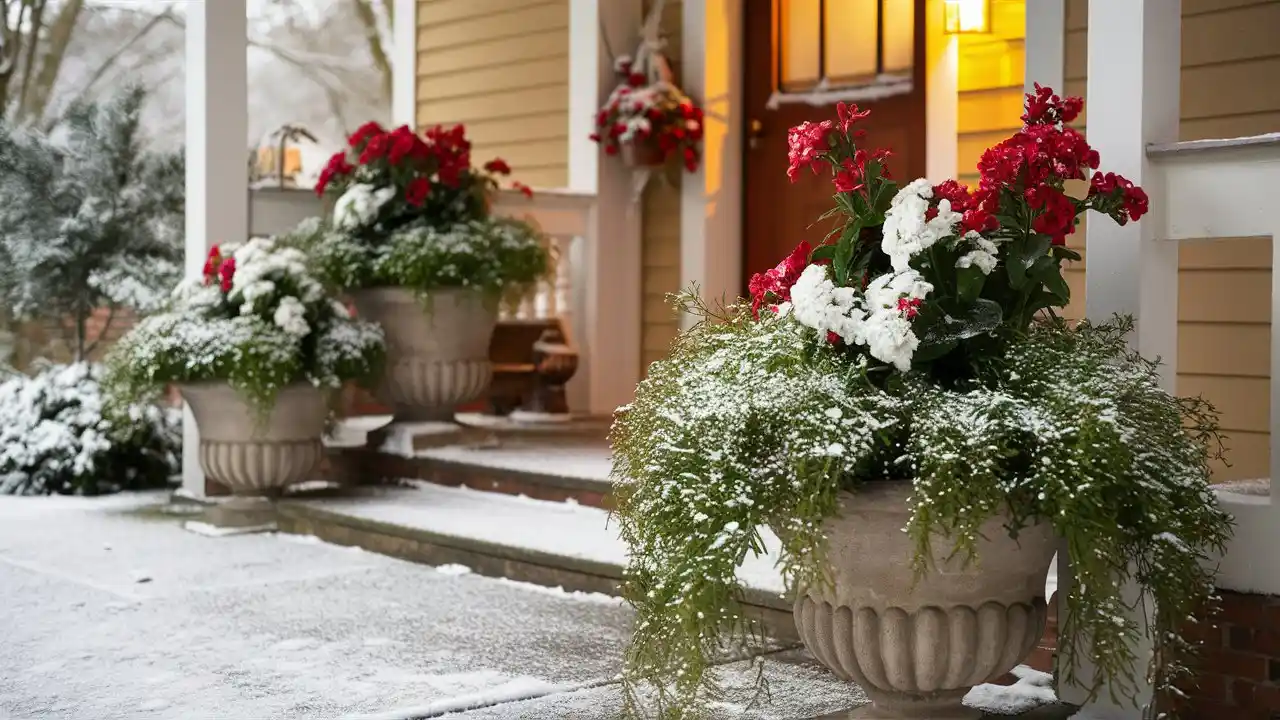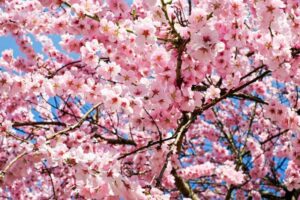As winter blankets the world in crisp white, most flowers retreat, leaving our porches barren and lifeless. However, certain hardy blooms bravely rise to the challenge, offering color and cheer even in the coldest months. This blog post explores the enchanting world of winter flowers for your front porch.
Crocus

One of the most delightful heralds of spring, the Crocus often emerges in late winter, transforming even the frostiest landscapes into vibrant arrays of purple, yellow, and white. These perennial bulbs are easy to plant and care for, making them an excellent choice for your winter porch display.
Crocuses thrive best when planted in clusters, allowing their colors to pop vividly against the drab winter backdrop. With a height of only 3 to 6 inches, they can harmoniously coexist with other winter flowers or even evergreen foliage for an elevated aesthetic. It is particularly thrilling to see these flowers peeking through a light dusting of snow, symbolizing resilience and the promise of warmer days ahead.
In addition to their beauty, Crocuses also attract early pollinators such as bees, providing vital sustenance in the few months when food sources are scarce. For best results, choose well-draining soil and a sunny location on your porch. Crocus bulbs can be planted in pots or directly in the ground, offering versatility in floral arrangements. Their early bloom means they’ll brighten up your space just as the days start to lengthen.
Cyclamen
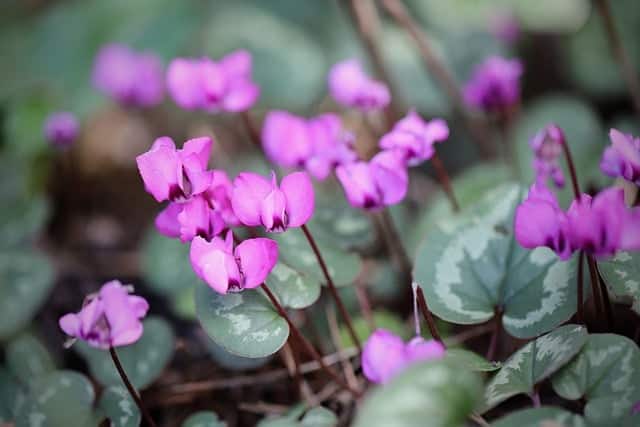
Another stunning option for winter, Cyclamen adds a splash of vibrancy with its heart-shaped leaves and charming upward-facing flowers, available in various shades of pink, red, and white. These perennial plants are not only aesthetically pleasing but are also known for their ability to thrive in cooler temperatures, making them ideal for winter arrangements.
Cyclamen prefers a sheltered location with bright, indirect light—ideal for a shaded porch or a spot that receives morning sun. Their distinctive tuberous roots store moisture, allowing Cyclamen to survive even if you occasionally forget to water them. This self-sufficiency means you can enjoy their beauty without an overwhelming commitment to care.
Moreover, Cyclamen are often seen as symbols of love and affection, which can add a personal touch to your home’s entryway. Position them in decorative pots, or combine them with other winter flowers to create a lush focal point. When their blooms fade, the attractive foliage remains to provide structure and interest until spring finally arrives.
Wake Robin
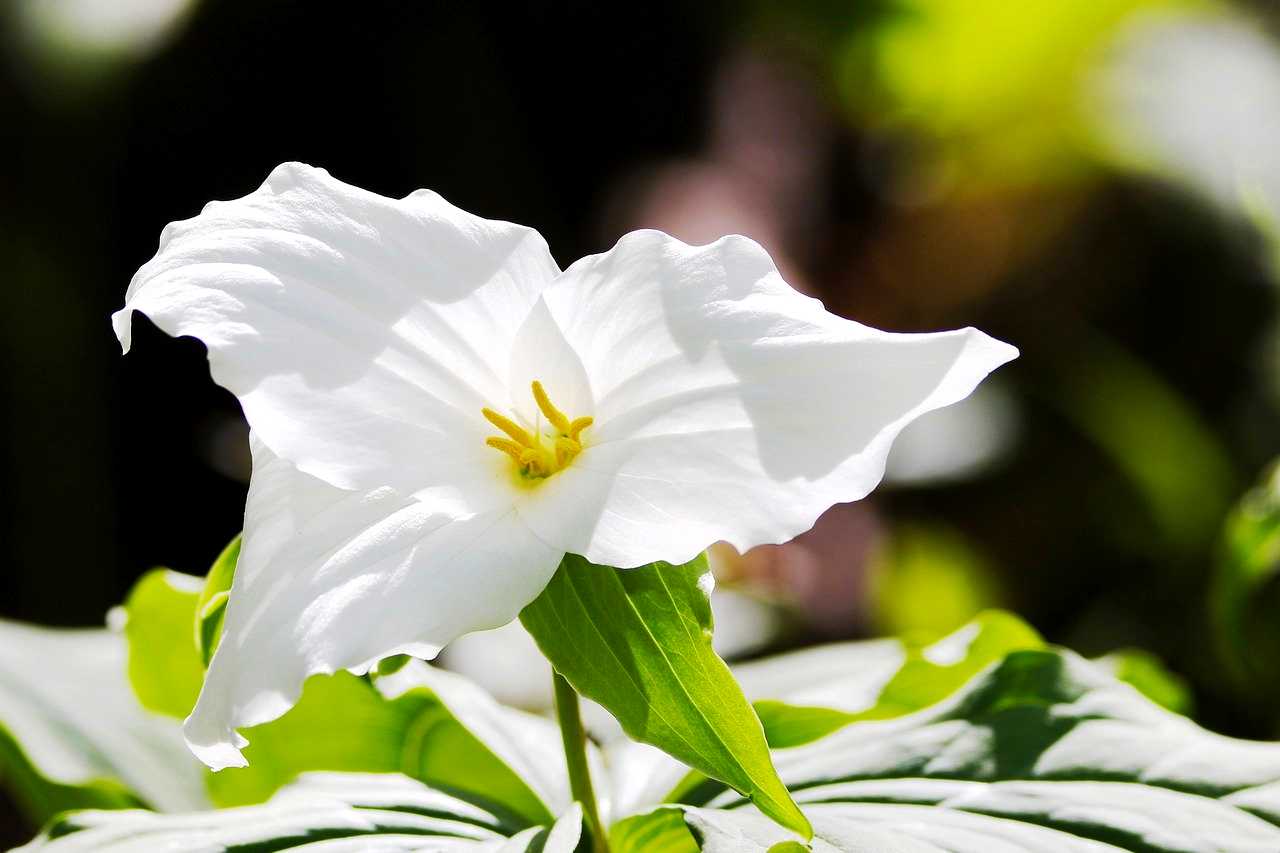
Wake Robin, also known as Trillium, offers a different kind of beauty to your winter porch. This native woodland plant showcases three-petaled flowers that can be white, pink, or deep red, depending on the species. While Wake Robin isn’t traditionally seen as a porch plant because of its preference for partial shade and slightly acidic soil, its uniqueness can introduce an exciting visual element to your outdoor space.
Often blooming in early spring, Wake Robin can be coaxed to bloom earlier in milder climates, timing its emergence perfectly with the warm sun emerging from winter. They thrive in well-drained, rich soil, making them suitable for pots that are amended with organic matter to create an optimal growing environment. Their lush green leaves provide visual interest, even when the flowers are not in bloom, making them a year-round choice.
One of the standout characteristics of Wake Robin is its low growth habit, typically reaching heights of only 12-15 inches, allowing it to blend effortlessly into existing porch arrangements. You can plant them alongside Crocus and Cyclamen for a layered look, celebrating the transition from winter to early spring in style.
Winter Aconite
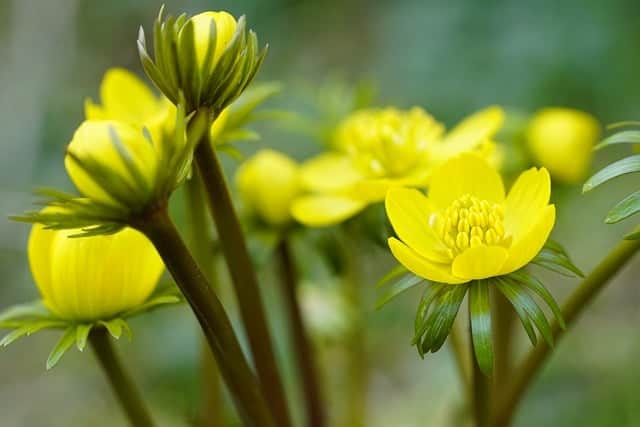
Winter Aconite (Eranthis hyemalis) is a remarkable flower that dares to bloom when the winter landscape appears drab and lifeless. With its bright, golden-yellow, cup-shaped flowers, this plant can bring a radiant touch to your porch. Their usual bloom time is between January and March, depending on regional temperatures, making them one of the first harbingers of spring.
These perennial bulbs thrive in well-drained, rich soil, and they prefer full sun to partial shade, which makes them adaptable for various porch settings. When planted in groups, Winter Aconites can create a breathtaking carpet of color, coupled with their dark green, palmate leaves that emerge from beneath the flowers. Their unique appearance captures the imagination, often eliciting joyful anticipation for the warmer months ahead.
Additionally, Winter Aconites are low maintenance, requiring minimal care once established. They can naturalize over time, spreading joyfully in gardens, but can also be contained in pots for a more structured display. Pairing them with evergreen arrangements creates a striking contrast, emphasizing their sunny disposition amidst winter’s chill.
Persian Violet
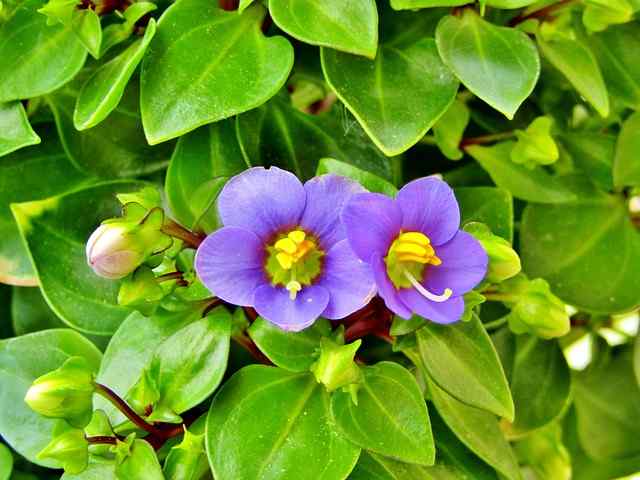
Persian Violet (Exacum affine), not to be confused with the traditional violet, is a vibrant winter bloomer that adds a pop of color to your front porch. Originating from the Arabian Peninsula, this delightful flower features clusters of small, fragrant blooms in shades of blue, purple, and pink. The sweet scent they exude enhances their appeal, inviting not only visual admiration but also sensory enjoyment.
These delightful plants prefer cooler temperatures and can thrive indoors or outdoors, making them a versatile option for your winter display. When growing Persian Violet, choose a location that offers bright, indirect light and well-draining soil. Regular watering is key, though care should be taken to avoid over-watering, as they do not tolerate soggy roots.
Persian Violets make an excellent choice for pot arrangements, where their delicate blossoms can be complemented by contrasting foliage. They can also serve as charming centerpieces on a table or as part of a larger floral arrangement that celebrates seasonal beauty. With proper care, this plant will bloom consistently from late winter into early spring, providing a continuous showcase of color that can brighten even the grayest days.
Winter Iris

The Winter Iris (Iris unguicularis), also known as the Algerian Iris, elegantly adorns porches with striking blue to purple flowers that emerge from slender stems. Blooming in winter and early spring, this perennial offers beauty when many other plants are dormant. Not only does it captivate the eye, but it also brings with it a sturdy resilience that makes it a perfect fit for winter gardens.
Winter Iris thrives best when situated in a full sun or partial shade area, boasting excellent drought tolerance once established. Their ability to flourish in poor soil conditions allows for creative planting opportunities, making them suitable for containers, rock gardens, or directly in the ground alongside other winter blooms.
These irises often flower in clusters, creating a stunning show of color that uplifts any winter landscape. Their unique shape adds architectural interest, whether they are displayed in a pot or massed among other flowers in a border. Combining Winter Iris with earlier blooming flowers such as Crocus can create a beautiful narrative of transitioning seasons, with their blooms serving as a reminder that spring is nearing.
Christmas Rose
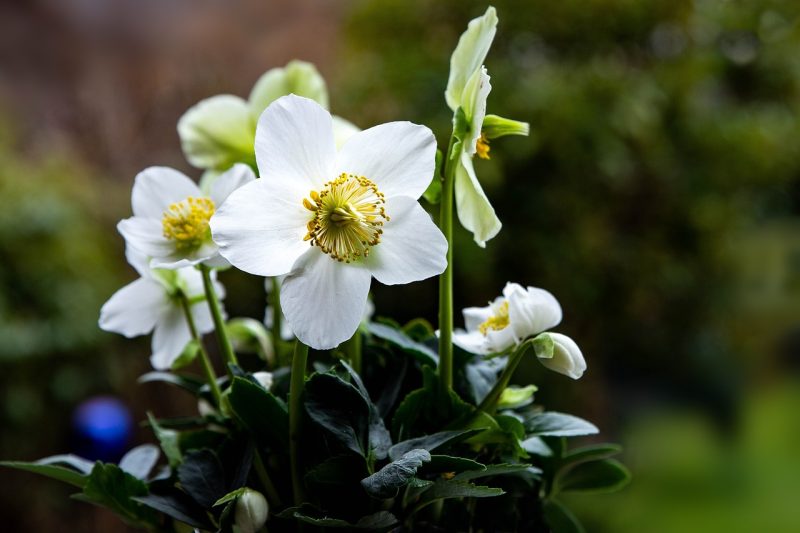
The Christmas Rose (Helleborus niger) is a true winter gem, offering delicate beauty and the promise of resilience. Despite its name, this enchanting perennial is not a true rose. Instead, it belongs to the buttercup family and is revered for its exquisite, cup-shaped white flowers that can stand out beautifully against a backdrop of winter’s snow. What sets this flower apart is its ability to bloom as early as Christmas, providing a festive touch to any front porch.
Christmas Roses thrive in partial shade and prefer well-drained soil, making them ideal for garden beds or pots that receive some morning light. Their leathery, evergreen leaves remain lush throughout the winter months, providing structure and interest even when the flowers are not in bloom. Additionally, the blooms of the Christmas Rose can persist until late winter or early spring, offering long-lasting beauty that many other winter flowers cannot match.
One of the most compelling features of the Christmas Rose is its ability to adapt to various garden conditions. This gives homeowners the opportunity to plant it in various locations, where it can often form small colonies over time, enhancing the porch display as the years go by. Pairing it with other early-blooming flowers can create a stunning winter garden vignette that heralds the arrival of spring.
Distylium

While not a flowering plant in the traditional sense, Distylium is an extraordinary evergreen shrub that brings year-round structure and foliage to your winter porch display. Native to East Asia, this resilient plant boasts glossy, blue-green leaves and a bushy growth habit, providing a lush backdrop for seasonal blooms. In late winter to early spring, Distylium does produce small, inconspicuous flowers that appear in clusters, typically in shades of red or pink, but it is primarily valued for its striking foliage and overall form.
Distylium excels in a variety of climates and can tolerate shade, making it particularly useful for porches that may not receive full sun. It’s low maintenance, drought-resistant, and pest-resistant, requiring minimal care while providing a beautiful green presence. This shrub fits seamlessly into container gardens or can be used as a framing element in larger arrangements, complementing winter flowers and enhancing the visual appeal of your porch.
This hardy plant can serve as a canvas for seasonal decorations, allowing bold blooms to shine in the foreground. Its evergreen nature means that even when other plants go dormant, Distylium will maintain a vibrant look, ensuring that your front porch stays visually appealing throughout winter. Consider using Distylium as a backdrop for your Christmas Rose and Amaryllis, creating a lush, layered effect that captures the warmth of the season.
Amaryllis
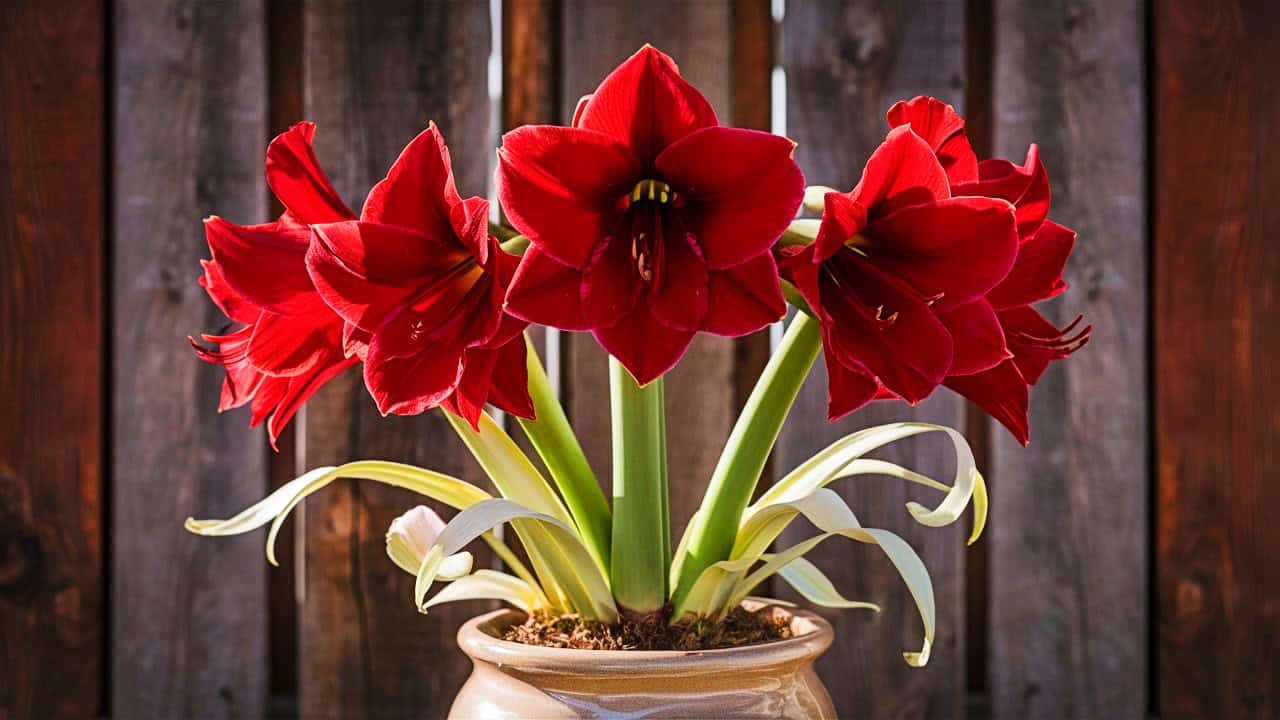
When it comes to vibrant winter blooms, the Amaryllis stands out as a quintessential choice for enhancing your front porch. With its large, trumpet-shaped flowers available in a stunning array of colors—including red, pink, white, and even bi-color varieties—this flower commands attention and adds a festive flair that feels perfect for winter celebrations.
Amaryllis thrives in containers, allowing you to position its striking blooms wherever they will garner the most admiration. They require well-draining soil and should be watered sparingly; the bulbs prefer to dry out slightly between waterings. To enjoy their impressive blossoms, plant the bulbs in pots by late autumn or early winter, ensuring they receive bright, indirect sunlight.
While Amaryllis bulbs typically take around 6 to 8 weeks to bloom after planting, the anticipation of their arrival is worth the wait. The blooms can continue to flourish into early spring, providing a delightful display that can be enjoyed during holiday gatherings and beyond. As they bloom, their grandeur becomes a focal point that elevates your porch aesthetic.
To maximize impact, consider grouping several pots of Amaryllis together, using varied colors and complementary styles. This grouping can create a dramatic and cheerful winter display that beautifully contrasts with the subdued tones of the season.
Daphne
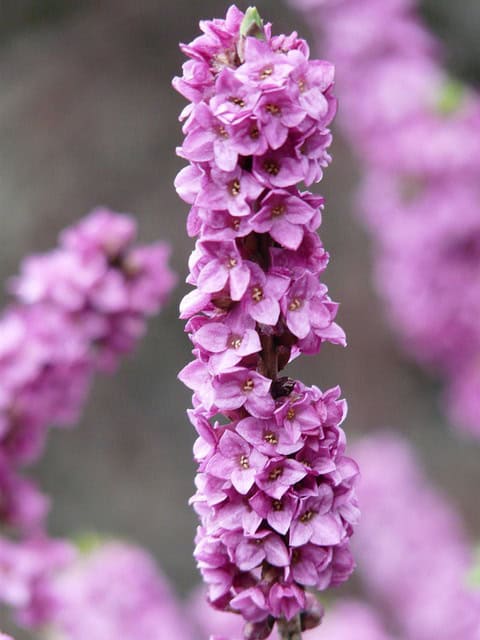
Daphne is a fragrant shrub that transforms your front porch into a sensory delight during the winter months. Known for its enchanting, sweet-smelling flowers, Daphne (particularly Daphne odora) typically blooms from late winter to early spring, showcasing clusters of delicate pink or white blooms. The combination of fragrance and visual appeal makes it a beloved choice for gardeners seeking to enhance their winter displays.
One of the advantages of incorporating Daphne into your porch decor is its evergreen foliage, which stays lush throughout the winter, providing excellent textural contrast against other winter flowers. This shrub prefers well-draining soil and partial shade, making it versatile for various garden placements, whether potted or planted directly in the ground. Additionally, it’s a relatively low-maintenance plant when established, requiring minimal pruning and watering.
Daphne’s blooms not only attract pollinators, such as bees, but their captivating scent can fill the air on milder days, inviting visitors to linger and appreciate the beauty of winter gardens. Consider placing Dahlia near entryways or outdoor seating areas, allowing its fragrance to welcome guests and enhance their experience. Coupled with other winter flowers, Daphne offers an elegant touch of sophistication and allure.
Daffodil
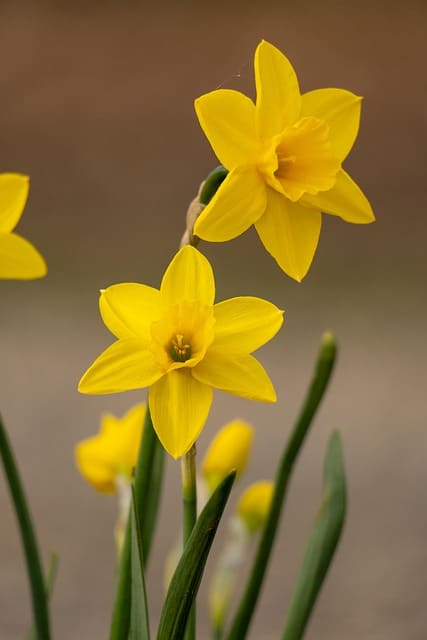
Daffodils (Narcissus) are a classic flower that signals the arrival of spring, but these resilient bulbs can also grace your front porch as winter draws to a close. Known for their cheerful yellow and white blooms, Daffodils typically begin to emerge in late winter to early spring, creating a brilliant burst of color that can brighten even the gloomiest days.
Planting Daffodils is a straightforward process; they thrive in well-draining soil and prefer full sun to partial shade. When planted in groups or clusters, Daffodils create a striking visual impact, making them a favorite choice for pots or garden beds. Their hardiness means they can endure frosty temperatures, allowing them to be among the first flowers to appear in a winter garden.
One of the standout features of Daffodils is their sweet fragrance, which enhances the overall sensory experience of your porch display. Additionally, these bulbs are toxic to deer and rodents, making them a wise choice for gardens prone to hungry pests. Pairing Daffodils with other early bloomers, such as Crocus or Pansies, creates an appealing tapestry of colors and textures that can breathe new life into your winter landscape.
Pansies

Pansies (Viola tricolor var. hortensis) are perhaps the quintessential winter flower, cherished for their vibrant hues and heartwarming charm. These hardy annuals can withstand chilly temperatures, making them a popular choice for enhancing winter porch displays. Their distinctive “faces” come in a rich variety of colors—from deep purples to sunny yellows—allowing ample opportunity for creative arrangements.
One of the key advantages of Pansies is their robust nature; they can continue to thrive even amidst frost, providing an enduring source of color through winter. When planted in containers or hanging baskets, they light up any porch with their showy blooms, often lasting from fall through early spring. They prefer well-draining soil and will benefit from regular watering, especially during dry spells.
Pansies can also serve as excellent companions for other winter flowers, creating a beautiful contrast with the greenery of other plants like Daphne or the dainty blooms of Daffodils. Their compact growth habit allows them to be effective in both small and large spaces, making them adaptable to various design schemes. Additionally, their vibrant blooms are known to flourish during cooler temperatures, allowing them to stand proud when other seasonal flowers may struggle.
Heucheras
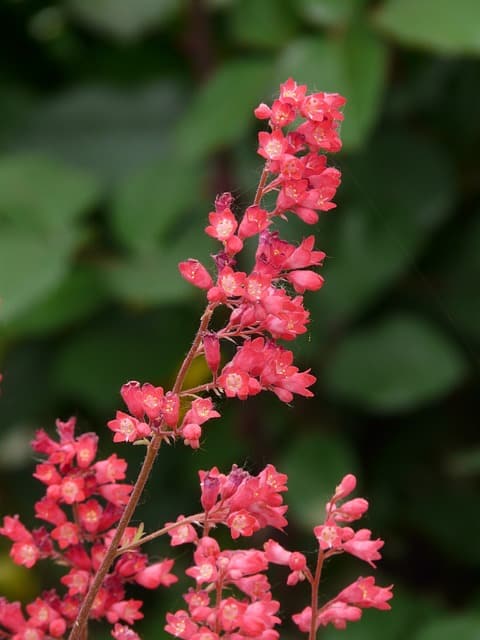
Heucheras, commonly known as coral bells, are a versatile and stunning addition to any winter porch display. Renowned for their colorful foliage, these perennial plants thrive even in colder climates. With leaves in a variety of hues—from deep burgundy to pale lime green—Heucheras infuse life into winter gardens. While they may not produce extravagant flowers in the depths of winter, the beauty of their foliage is an attraction all its own.
Planting Heucheras in well-draining soil with partial shade to full sun exposure will reward you with a robust display. They are particularly noted for their adaptability; they can thrive in various conditions, making them an excellent choice for pot arrangements or as ground cover. Plus, their resilient nature means that they perform well throughout the winter, maintaining their vibrant colors and decorative appeal.
These charming plants also exude a touch of elegance when combined with other winter flowers like Pansies or Daffodils. Their architectural leaves provide an excellent contrast to the softness of blooming flowers, creating a balanced visual composition. As winter transitions into spring, Heucheras can continue to grace your porch with their stunning foliage while providing a lush backdrop for the upcoming seasonal blooms.
Heather
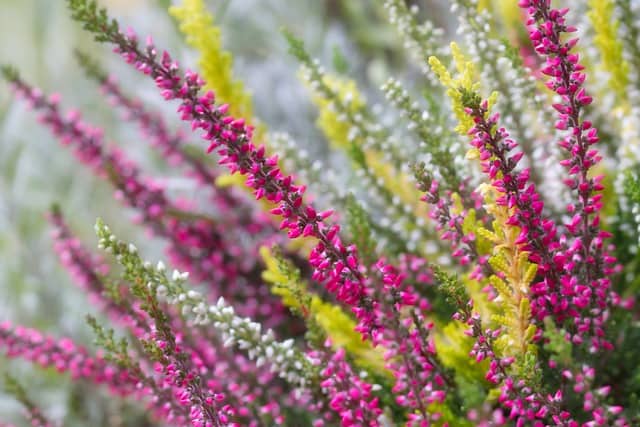
Heather (Calluna vulgaris) is a delightful evergreen shrub that brings a burst of color and texture to your winter front porch. With its small, bell-shaped flowers, usually in shades of purple, pink, and white, Heather creates a captivating display that can liven up a winter garden. This hardy plant blooms primarily from late summer through fall, but its evergreen needles offer a year-round interest that enriches your porch during the winter months.
Heather thrives in acidic soils and prefers a spot with full sun or light shade. Its compact growth habit makes it perfect for container gardening, where its vibrant colors can pop against the neutral tones of winter. When planted in pots, Heather is not only decorative but also functional; it can help prevent frost damage to more tender plants grouped nearby.
In addition to visual appeal, Heather attracts beneficial pollinators during its blooming period, supporting the local ecosystem. To enhance its beauty, consider combining Heather with other winter flowers like Hellebores or even ornamental grasses, which can complement the texture and color palette while creating a layered look that is inviting and intriguing.
Hellebores
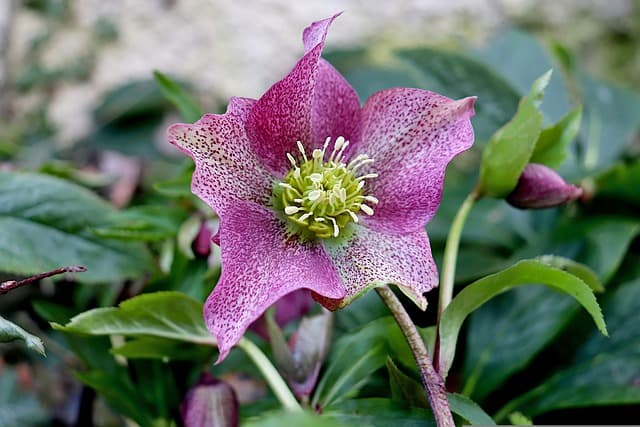
Hellebores, or Lenten Roses, are cherished for their exquisite, nodding blooms that can emerge from the ground even when snow still blankets the garden. With rich colors ranging from deep burgundy to soft pastels, Hellebores make a striking winter flower choice for a front porch. Their petals can sometimes appear speckled or marbled, adding an exquisite detail that delights any passerby.
This hardy perennial typically begins to bloom in late winter and can continue into spring, making it a fantastic choice for early seasonal color. Hellebores prefer partially shaded areas with well-draining soil, making them well-suited for mixed containers alongside darker foliage plants like Heucheras. Their evergreen leaves also remain attractive throughout the winter, providing continuous interest even when the flowers aren’t blooming.
One of the most compelling features of Hellebores is their ability to thrive in a variety of conditions, adapting well to poorer soils, which can make them a low-maintenance option for gardeners. Combining Hellebores with Pansies or even taller plants like Daphne can create a stunning visual contrast, ranging from rich colors to delicate details that will captivate your guests.
Cyclamen

Cyclamen are delightful winter flowers known for their distinctive, heart-shaped leaves and gorgeous blooms that can add a splash of color to your front porch. Available in a range of colors, from vivid pinks to pure whites, these plants are especially cherished for their unique upswept petals that appear to dance above the foliage. Cyclamen thrive in cooler temperatures, making them ideal companions for winter gardening.
These tuberous perennials prefer well-draining soil and partial shade, making them perfect for pots or shaded areas of your porch. They can bloom from December through March, providing a cheerful display when other plants may be dormant. Their flowers often exhibit a subtle fragrance, adding yet another layer of allure to your outdoor space.
One of the key attributes of Cyclamen is their ability to signal the approach of spring even when surrounded by winter’s chill. Combining them with other winter flowers, such as Snowdrops or Hellebores, can create an enchanting tableau that brightens your porch and evokes a sense of warmth and hope. Their striking appearance is sure to intrigue visitors and passersby alike, allowing your porch to stand out even in the depths of winter.
Snowdrops
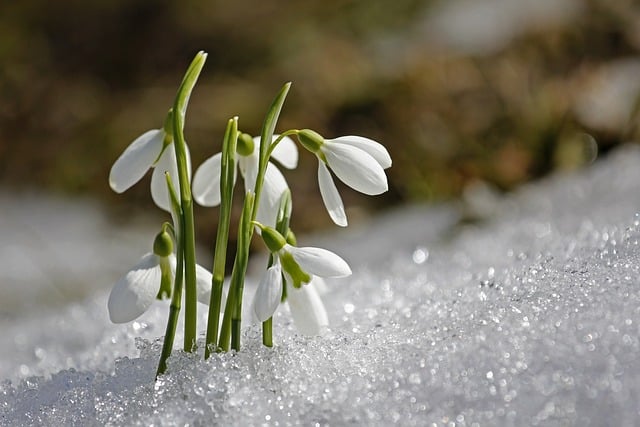
Snowdrops (Galanthus nivalis) are often heralded as the first sign of spring, appearing when winter’s grip is still strong. These dainty, white flowers bloom between late winter and early spring, often pushing through the snow to make their presence known. Renowned for their drooping, teardrop-shaped blooms, Snowdrops evoke a feeling of purity and renewal, making them a quintessential choice for winter-themed porch displays.
These hardy bulbs thrive in well-drained soil and can tolerate shade, making them versatile for various planting locations. When planted in clusters, they can create an enchanting carpet of white that brightens any winter garden. Snowdrops are also very easy to grow and require minimal maintenance, making them an attractive option for both novice and experienced gardeners.
To complement your Snowdrops, consider pairing them with colorful seasonal plants like Pansies or even bright Cyclamen. The contrast between the delicate white of Snowdrops and the vibrant colors of companion flowers can create a lovely visual effect that captures the essence of winter rejuvenation. Planting these charming flowers near your porch can provide a welcoming signal that spring is on its way, drawing in lingering looks from those passing by.
Wintergreen
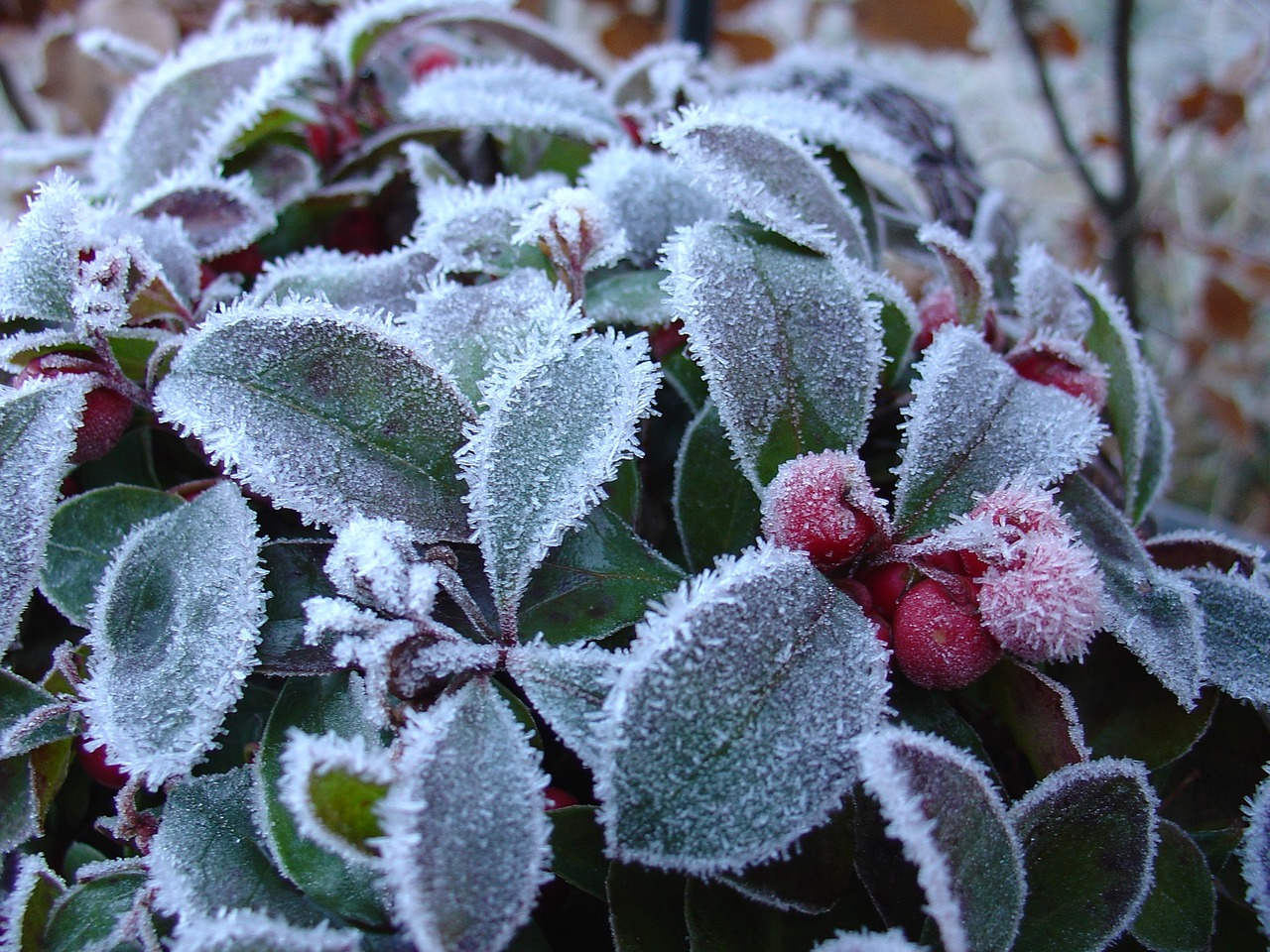
Wintergreen (Gaultheria procumbens) is a delightful evergreen ground cover that brings vibrant color and texture to your winter porch. Known for its glossy, dark green leaves and small, round red berries, Wintergreen offers an appealing contrast against the typical frost-laden landscape. Its ability to thrive in cold temperatures makes it a resilient choice for winter displays.
The aromatic leaves emit a refreshing minty scent when crushed, adding an unexpected sensory experience to your outdoor space. Wintergreen thrives in acidic, well-drained soil and prefers partial shade, making it suitable for pots or as a filling plant in garden beds. This evergreen shrub not only provides year-round coverage but also attracts birds, who enjoy feasting on its berries during the colder months.
Incorporating Wintergreen into your porch display alongside other winter flowers like Cyclamen and Snowdrops can create a dynamic arrangement full of texture and color. The combination of the eye-catching red berries with the soft blooms of Cyclamen or the delicate white of Snowdrops can provide visual interest that captivates the eye.
Winter Aconites

Winter Aconites (Eranthis hyemalis) are a cheerful herald of spring that often emerges while winter is still holding strong. These delightful yellow blooms are among the first flowers to appear, typically flowering from late winter through early spring. With their bright, cup-shaped blossoms nestled among bright green, lobed leaves, Winter Aconites offer a promising pop of color against the sleepy winter landscape.
These hardy perennials thrive in well-drained soil, preferring partial shade to full sun. They are particularly effective when planted in groups, creating a vibrant carpet of sunny yellow that can enliven your front porch area as the days begin to lengthen. Not only do they bring beauty, but they also serve as a valuable food source for early pollinators, such as bees, seeking nectar after a long winter.
To make the most of Winter Aconites, consider pairing them with darker foliage plants, such as Heucheras or Daffodils, to create a dramatic contrast. Their cheerful disposition is a perfect way to usher in the promise of spring, and the combination of colors and textures will captivate the attention of anyone visiting your home.
Ornamental Kale
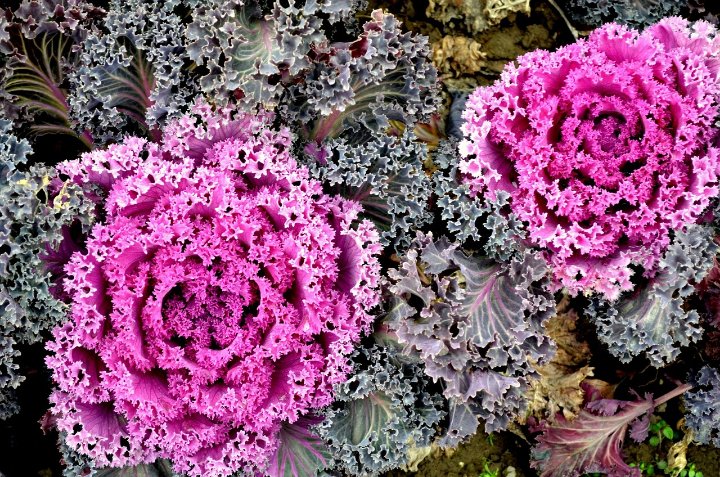
While we often think of foliage as a backdrop to flowers, Ornamental Kale (Brassica oleracea) proves that leafy greens can take center stage in the garden, especially during winter months. Characterized by its vibrant colors, ranging from deep purples and pinks to white, Ornamental Kale creates a striking display that thrives in chilly temperatures. As the weather cools, the colors of this hardy plant often intensify, making it a lively addition to any winter porch.
Ornamental Kale prefers well-drained soil and can be planted in pots or directly in garden beds. It enjoys full sun to partial shade and is relatively low-maintenance. This plant not only enhances visual intrigue but is also edible, adding a culinary twist to its ornamental features. While many choose to display it solely for its beauty, the ability to incorporate it into seasonal cooking makes it a practical choice as well.
To create an appealing aesthetic, consider combining Ornamental Kale with other winter flowers, such as Pansies and Cyclamens, for a colorful, textured composition. The combination of leafy greens with flowering plants can result in a sophisticated winter arrangement that is both visually striking and inviting, perfect for welcoming guests to your home.
Winter Heather
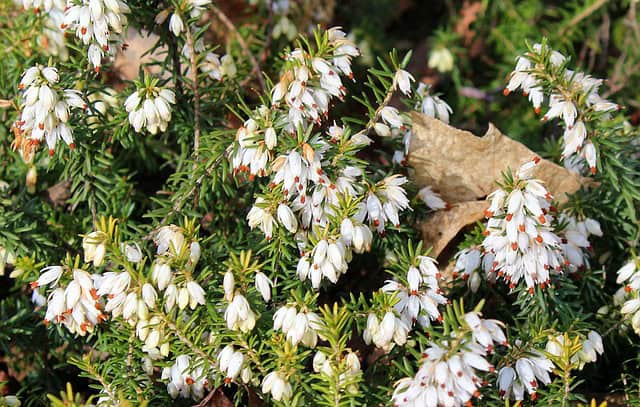
Winter Heather (Erica carnea) is a charming evergreen shrub that thrives in colder climates, providing much-needed color during the winter months. With its low-growing habit, Winter Heather produces an abundance of small, tubular flowers—typically in shades of pink, purple, and white—which bloom from late winter to early spring. This hardy plant is particularly valued for its ability to maintain lush foliage and vibrant flowers in temperatures that would leave many other flowers dormant.
Ideal for well-drained, acidic soils, Winter Heather prefers full sun or partial shade, making it a beautiful choice for containers on a sunny porch or as part of a garden border. Its dense, evergreen leaves create an attractive ground cover, accentuating the flowers and providing a stunning display that can survive through winter’s chill. In addition to its visual appeal, Winter Heather is known to attract bees, helping to sustain local pollinator populations.
Combining Winter Heather with plants like Winter Aconites and Cyclamen can create a harmonious winter display full of contrasting colors and textures. The eye-catching blooms of Winter Heather can beautifully complement the warm yellows of Aconites, while providing a lush backdrop for the delicate flowers of Cyclamen. Together, these plants can transform your front porch into a festive haven filled with life and color, even amidst the icy grasp of winter.
Coral Bells

Coral Bells (Heuchera) are stunning perennial plants that bring an explosion of color and texture to the winter porch. Known primarily for their vibrant foliage, which comes in a wide variety of shades—ranging from deep purples and reds to vibrant greens—Coral Bells thrive in the colder months, making them a standout in the winter landscape. While their flowers may be less prominent in winter, the colorful leaves remain attractive and offer a level of interest that few other plants can match.
These hardy plants prefer well-drained soil and do exceptionally well in partial shade, although they can also tolerate full sun. One of the key benefits of Coral Bells is their adaptability; they can thrive in both pots and garden beds, making them a versatile option for any porch. Seasonal care involves ensuring they receive adequate water and avoiding overflooding, which can lead to root rot.
To create a captivating winter arrangement, consider pairing Coral Bells with other hardy plants like Ornamental Cabbage or even Winter Heather. The varied colors and textures of Coral Bells enhance the overall aesthetic, while their unique foliage can provide an interesting contrast to the softer blooms of companion plants. Additionally, the attractiveness of Coral Bells extends beyond winter as their foliage can endure into spring, allowing these vibrant plants to anchor your garden design year-round.
Bergenia
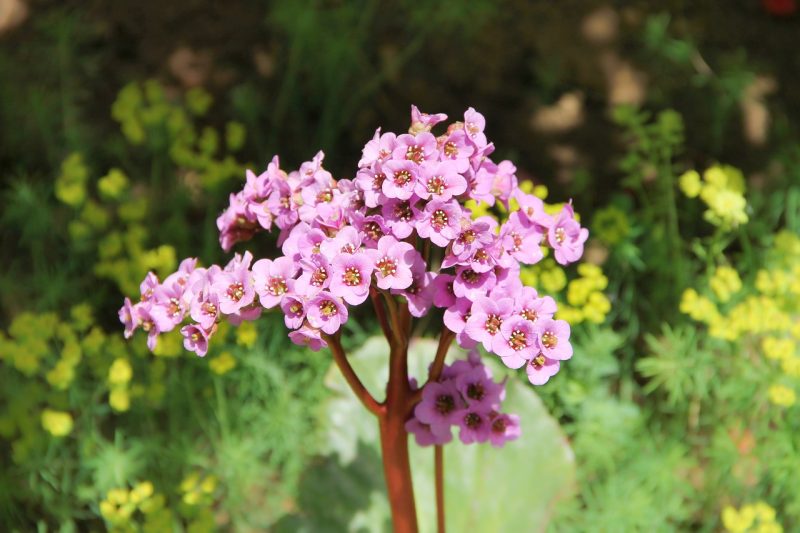
Bergenia, often referred to as “Elephant Ears” due to the large, thick leaves, is a winter perennial that adds a unique visual element to your front porch. These plants feature broad, leathery foliage that can take on a lovely purplish hue as winter progresses, providing lush greenery that stands out starkly against the cold landscape. Bergenia also produces clusters of charming pink or white flowers that bloom in early spring, bringing anticipation of warmer weather even in the dead of winter.
Bergenia flourishes in a range of soil types but performs best in well-draining, fertile ground and it prefers a partially shaded location. This plant is particularly resilient and can adapt to both garden beds and container arrangements, making it a practical choice for winter displays on the porch. The substantial leaves and sturdy stems of Bergenia give it a bold presence, providing a strong focal point amid more delicate winter blooms.
For a striking winter garden, consider planting Bergenia alongside Coral Bells or even Pansies. The contrast between Bergenia’s robust foliage and the lighter, colorful leaves of Coral Bells can create a visually interesting tableau. Furthermore, as Bergenia blooms in spring, you can enjoy the transition from the winter season to the spring garden, making it a dynamic addition to your porch display.


